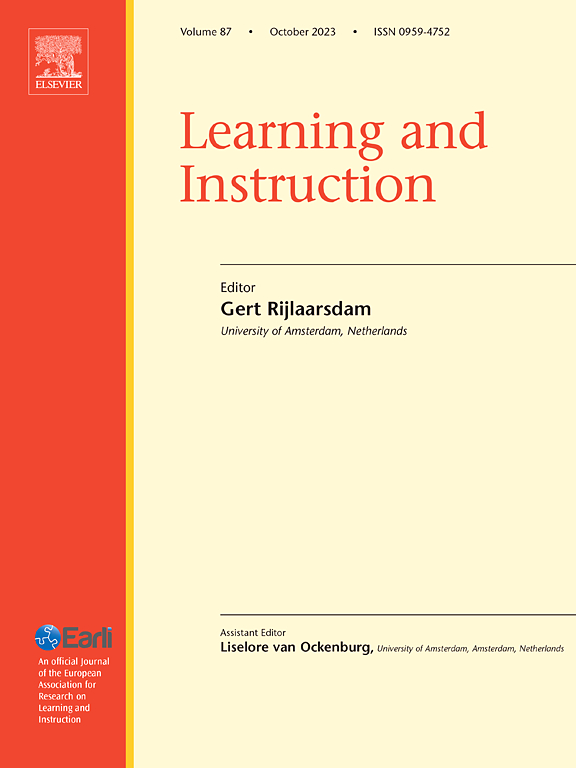Differences between low and high achievers in whole-classroom dialogue participation quality
IF 4.7
1区 教育学
Q1 EDUCATION & EDUCATIONAL RESEARCH
引用次数: 0
Abstract
Background
Academically productive dialogue activities in classrooms aspire to be inclusive, such that students of all capabilities participate meaningfully and equally in discussions.
Aim
We empirically examine the extent to which this aspiration is achieved regarding students of different prior achievement levels.
Sample
Low- (N = 33), mid- (N = 90), and high-achieving (N = 22) upper elementary students participated in whole-classroom discussions around texts, facilitated by six highly motivated, trained teachers.
Method
Based on a quantitative ethnography approach, we coded 5975 separate speech turns and compared aggregated differences across the three subgroups using Epistemic Network Analysis (ENA).
Results
Whereas no differences were found in amount of speech turns, statistically significant differences were found in the quality of participation: Low-achievers' discussion participation was characterized by recitation-style talk, reduced network connectivity, and repetitive loops, compared to higher connectivity and more complex argumentative reasoning in their high-achieving classmates' network model. A follow-up qualitative analysis uncovered some of the social dynamics behind this inferior participation pattern, and highlighted the potentially stymieing behavior of peers.
Conclusion
The findings underscore the need for more empirical research that takes into account differences in quality of student participation in dialogic activities and the reasons behind it.
低、高成就者在全课堂对话参与质量上的差异
课堂上富有学术成果的对话活动渴望具有包容性,这样所有能力的学生都能有意义地和平等地参与讨论。我们从经验上考察了不同先前成就水平的学生实现这一愿望的程度。样本:低年级(N = 33)、中年级(N = 90)和高年级(N = 22)的小学生在六位高度积极、训练有素的教师的指导下,参与了围绕课文的课堂讨论。方法基于定量人种志方法,我们编码了5975个独立的语音转折,并使用认知网络分析(ENA)比较了三个亚群之间的总体差异。结果虽然在发言次数上没有发现差异,但在参与质量上却发现了统计学上显著的差异:与高成就同学的网络模型中更高的连通性和更复杂的论证推理相比,低成就同学的讨论参与表现为背诵式的谈话、减少的网络连通性和重复循环。一项后续的定性分析揭示了这种低劣参与模式背后的一些社会动态,并强调了同伴的潜在阻碍行为。结论研究结果强调需要更多的实证研究,考虑到学生参与对话活动的质量差异及其背后的原因。
本文章由计算机程序翻译,如有差异,请以英文原文为准。
求助全文
约1分钟内获得全文
求助全文
来源期刊

Learning and Instruction
Multiple-
CiteScore
11.30
自引率
4.80%
发文量
109
期刊介绍:
As an international, multi-disciplinary, peer-refereed journal, Learning and Instruction provides a platform for the publication of the most advanced scientific research in the areas of learning, development, instruction and teaching. The journal welcomes original empirical investigations. The papers may represent a variety of theoretical perspectives and different methodological approaches. They may refer to any age level, from infants to adults and to a diversity of learning and instructional settings, from laboratory experiments to field studies. The major criteria in the review and the selection process concern the significance of the contribution to the area of learning and instruction, and the rigor of the study.
 求助内容:
求助内容: 应助结果提醒方式:
应助结果提醒方式:


